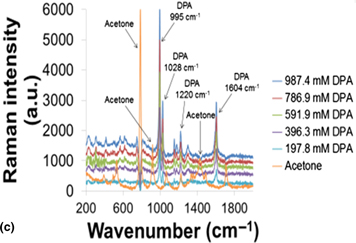Crossref Citations
This article has been cited by the following publications. This list is generated based on data provided by
Crossref.
Kim, Jang Ah
Wales, Dominic J.
Thompson, Alex J.
and
Yang, Guang‐Zhong
2020.
Fiber‐Optic SERS Probes Fabricated Using Two‐Photon Polymerization For Rapid Detection of Bacteria.
Advanced Optical Materials,
Vol. 8,
Issue. 9,
Sun, Guanliang
Li, Ning
Wang, Dan
Xu, Guanchen
Zhang, Xingshuang
Gong, Hongyu
Li, Dongwei
Li, Yong
Pang, Huaipeng
Gao, Meng
and
Liang, Xiu
2021.
A Novel 3D Hierarchical Plasmonic Functional Cu@Co3O4@Ag Array as Intelligent SERS Sensing Platform with Trace Droplet Rapid Detection Ability for Pesticide Residue Detection on Fruits and Vegetables.
Nanomaterials,
Vol. 11,
Issue. 12,
p.
3460.
Barveen, Nazar Riswana
Wang, Tzyy-Jiann
and
Chang, Yu-Hsu
2021.
Photochemical decoration of silver nanoparticles on silver vanadate nanorods as an efficient SERS probe for ultrasensitive detection of chloramphenicol residue in real samples.
Chemosphere,
Vol. 275,
Issue. ,
p.
130115.
Fabiano, Maria Aurora
Buccilli, Valeria
Maida, Pietro
and
Zavattaro, Davide
2022.
Use of Micronir Portable Device for Forensic Investigation on Supect's Hands: Confirmation of Manipulation of Cannabis Plants.
SSRN Electronic Journal ,
Nguyen, Thuy Van
Vu, Duc Chinh
Pham, Thanh Son
Bui, Huy
Pham, Thanh Binh
Hoang, Thi Hong Cam
Pham, Van Hai
and
Pham, Van Hoi
2022.
Quasi‐3D‐Structured Surface‐Enhanced Raman Scattering Substrates Based on Silver Nanoparticles/Mesoporous Silicon Hybrid.
physica status solidi (a),
Vol. 219,
Issue. 18,
Wang, Wei
Ma, Pinyi
and
Song, Daqian
2022.
Applications of surface‐enhanced Raman spectroscopy based on portable Raman spectrometers: A review of recent developments.
Luminescence,
Vol. 37,
Issue. 11,
p.
1822.
Kuehn, Makenzie
Bates, Kevin
Tyler Davidson, J.
and
Monjardez, Geraldine
2023.
Evaluation of handheld Raman spectrometers for the detection of intact explosives.
Forensic Science International,
Vol. 353,
Issue. ,
p.
111875.
Aligholizadeh, Dariush
Tewala, Youssef
Langford, Kameron
Hondrogiannis, Nicole
Chikkaraddy, Rohit
and
Devadas, Mary Sajini
2023.
Liquid-phase surface enhanced Raman spectroscopic detection of nerve agent motifs using gold nanostars.
Vibrational Spectroscopy,
Vol. 129,
Issue. ,
p.
103616.
Krishna, Sreelakshmi
and
Ahuja, Pooja
2023.
A chronological study of gunshot residue (GSR) detection techniques: a narrative review.
Egyptian Journal of Forensic Sciences,
Vol. 13,
Issue. 1,
Pyl, Courtney Vander
Menking-Hoggatt, Korina
Arroyo, Luis
Gonzalez, Jhanis
Liu, Chunyi
Yoo, Jong
Russo, Richard E.
and
Trejos, Tatiana
2023.
Evolution of LIBS technology to mobile instrumentation for expediting firearm-related investigations at the laboratory and the crime scene.
Spectrochimica Acta Part B: Atomic Spectroscopy,
Vol. 207,
Issue. ,
p.
106741.
Ma, Haikuan
Zhang, Shuwei
Yuan, Guang
Liu, Yan
Cao, Xuan
Kong, Xiangfeng
and
Wang, Yang
2023.
Surface-Enhanced Raman Spectroscopy (SERS) Activity of Gold Nanoparticles Prepared Using an Automated Loop Flow Reactor.
Applied Spectroscopy,
Vol. 77,
Issue. 10,
p.
1163.
Charles, Sébastien
Geusens, Nadia
and
Nys, Bart
2023.
Interpol Review of Gunshot Residue 2019 to 2021.
Forensic Science International: Synergy,
Vol. 6,
Issue. ,
p.
100302.
Ullah, Muhammad Farhat
Khan, Yousaf
Khan, M. Ijaz
Abdullaeva, Barno Sayfutdinovna
and
Waqas, M.
2024.
Exploring nanotechnology in forensic investigations: Techniques, innovations, and future prospects.
Sensing and Bio-Sensing Research,
Vol. 45,
Issue. ,
p.
100674.
Shafirovich, Taylor
Aligholizadeh, Dariush
Johnson, Mansoor
Hondrogiannis, Ellen
and
Devadas, Mary Sajini
2024.
Point-and-shoot: portable Raman and SERS detection of organic gunshot residue analytes.
Vibrational Spectroscopy,
Vol. 131,
Issue. ,
p.
103669.
Dalzell, Kourtney A.
Ledergerber, Thomas
Trejos, Tatiana
and
Arroyo, Luis E.
2025.
Incorporating organic gunshot residue into the forensic workflow: A study of preservation and stability of the pGSR and OGSR.
Forensic Chemistry,
Vol. 44,
Issue. ,
p.
100651.
Wongpakdee, Thinnapong
Nacapricha, Duangjai
and
McCord, Bruce
2025.
Modification of screen-printed electrodes using gold nanostructures for SERS detection of low explosives.
Forensic Chemistry,
Vol. 42,
Issue. ,
p.
100636.
Bodinthitikul, Nutdanai
Lertvanithphol, Tossaporn
Horprathum, Mati
Chaikeeree, Tanapoj
Nakajima, Hideki
Milawan, Suchanya
Phae-ngam, Wuttichai
and
Jutarosaga, Tula
2025.
Alternative plasmonic Ti-doped HfN thin films by reactive co-magnetron sputtering and their SERS performances.
Journal of Alloys and Compounds,
Vol. 1026,
Issue. ,
p.
180430.
